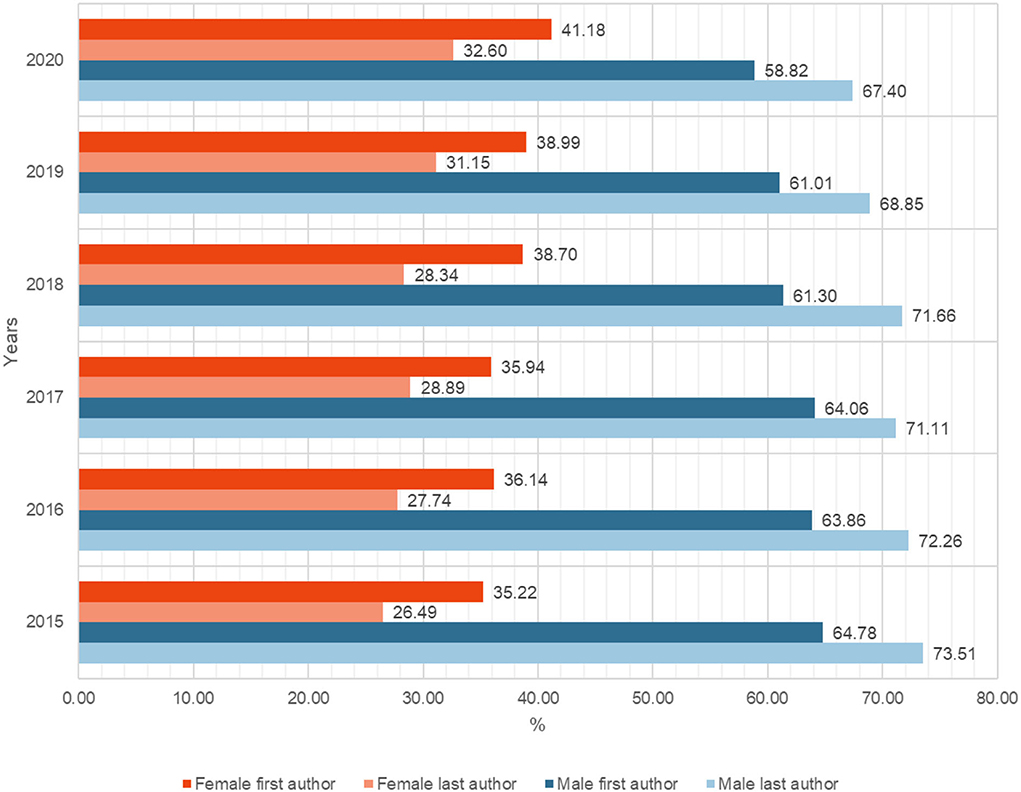- 1Department of Industrial Management, Industrial Design and Mechanical Engineering, Faculty of Engineering and Sustainable Development, University of Gävle, Gävle, Sweden
- 2Department of Information and Library Science, Complutense University of Madrid, Madrid, Spain
Higher education institutions (HEIs) have been undertaking considerable efforts to embed sustainability into their system; however, there have been limited studies on the incorporation of sustainability into research. In parallel, it has been found that women have an important role in contributing to sustainability since they are more engaged and have a more holistic perspective on sustainability than men. These two phenomena have resulted in limited studies about the contribution of women to sustainability research (i.e., in scientific publishing). A bibliometric analysis of more than 39,000 documents (with 147,090 authorships) was done to fill this gap, focusing on sustainability peer-review publications in Europe between 2015 and 2020. The results show that women's presence in sustainability research has been increasing during the last years; however, there are still few female authorship publications, even in fields that have been traditionally women-oriented. In addition, their publications have been less recognized by the scientific community. The results also show substantial gender differences in terms of author leadership, where female senior researchers are more likely to mentor female junior researchers than men. Female researchers tend to collaborate nationally, but they could improve their international collaboration since this can improve their research and impact. More support should be provided to female researchers to help foster women's sustainability engagement and holistic perspectives, reduce existing negative feedback loops, and increase positive ones. Achieving gender equality is sine qua non in achieving sustainable societies.
Introduction
During the last years, higher education institutions (HEIs) have been increasing considerably the incorporation of sustainability into their system elements (Desha et al., 2009; Lozano, 2010; Sammalisto et al., 2016), especially in Europe (Karatzoglou, 2013; Lozano et al., 2015, 2019). This has included, for instance, studies on governance, such as on board of directors and policies (Valls Martínez et al., 2019); campus operations (e.g., energy, waste, and water management) (Amaral et al., 2020); education (e.g., pedagogical approaches and competences) (Lozano and Barreiro-Gen, 2019); and assessment and reporting (Matten and Moon, 2004; Disterheft et al., 2012). However, there have been limited studies on the incorporation of sustainability in research (Withycombe Keeler et al., 2016; Torabian, 2019), particularly in scientific publishing (Leal Filho et al., 2021).
In parallel, research has found that women have an important role in contributing to sustainability. For example, women have a more holistic perspective on sustainability issues (Lozano and Barreiro-Gen, 2019) and have higher engagement levels than men (von Haartman et al., 2017). In HEIs, women have a more balanced view of sustainability dimensions when they teach sustainability (Lozano and Barreiro-Gen, 2019) and collaborate in a more egalitarian way in research than men (Araújo et al., 2017; Santos et al., 2021).
As a consequence of these two phenomena, there has been limited research on the contribution of women to sustainability research, particularly in scientific publications, which are a key indicator of scientific outputs (Huang et al., 2020), except for the paper by Khalikova et al. (2021). This article aims to fill this gap through the analysis of the role of women in sustainability peer-review publications in Europe.
Literature review
According to the European Commission (2021b), women represented more than 40% of academic staff on average in the European Union (EU) in 2019, but there were only ~25% of women with the title of full professor and fewer than 25% of heads of institutions in HEIs. In research, women represented around one-third (32.8%) of the total researchers at the European level (Eurostat, 2021). Although between 40 and 60% of doctoral graduates were women in the majority of EU Member States, their presence in senior academic positions was still quite low (see the Swedish Research Council, 2021). Women's underrepresentation persisted across research and development fields, even in disciplines where female researchers are more prevalent (European Commission, 2021a). Female researchers tended to have more part-time and precarious contracts than male researchers (European Commission, 2021a,b), and there were fewer female presidents and members of the highest decision-making body in national academies of science in the EU-27 (European Institute for Gender Equality, 2021), which is a reflection of an existing “glass ceiling” (Ekström Hagevall, 2021).
Despite a number of policies promoting gender equality that have been developed by the EU within the framework of the Gender Equality Strategy, such as the ones on research and innovation (European Commission, 2022), there are a number of issues that limit women's involvement in research, for instance, women tend to be invited to a lesser extent to participate in decision-making processes (Rosser, 2014); social networks, one of the success factors in research, tend to be homosocial, typically consisting of men (Aksnes et al., 2019); female researchers have less access to research time than male researchers (Swedish Research Council, 2021); women carry the main responsibility of academia non-promotable work (“academia housework”), such as serving on committees, administrative work, organization of conferences, and student service provision (Heijstra et al., 2017); and women have more difficulties balancing their professional and private lives (Morgan et al., 2021; European Commission, 2021a), especially if they care for children, since they tend to take on a greater responsibility in parenthood (Derrick et al., 2021).
Some studies (e.g., Grogan, 2019; Huang et al., 2020) have focused on gender differences in academic research, for example, in productivity and impact. Such differences between female and male researchers can be partially explained by the differences in the length of a research career and dropout rates (Huang et al., 2020). Dropout rates are usually higher in women, especially in science, technology, engineering, and mathematics (STEM), called “the leaky pipeline” phenomenon (Grogan, 2019). It should be noted that academia is not a unified culture, where every research discipline has its own characteristics regarding gender differences in, for example, publications and citations (Ghiasi et al., 2015), international collaboration (Paul-Hus et al., 2015; Aksnes et al., 2019), and between countries (Larivière et al., 2013; Khalikova et al., 2021).
In general, men tend to publish more scientific papers than women in most European countries (Ghiasi et al., 2015; Paul-Hus et al., 2015; Aksnes et al., 2019), except for countries with low scientific production, for example, in Eastern Europe (i.e., Macedonia, Latvia, Ukraine, and Bosnia and Herzegovina), where the rate of female authorships is higher than that of male authorships. This gender gap increased due to COVID-19 lockdowns, resulting in lower publications by female researchers (Ucar et al., 2022) and decreases in female research leadership (Bell and Fong, 2021).
Women are significantly less likely to be credited with authorship than men (Ross et al., 2022). Female researchers receive fewer citations in their papers than male researchers (Chatterjee and Werner, 2021), even when publishing in journals with a higher impact factor (Ghiasi et al., 2015). Publications have fewer citations when the name of the author is “more” feminine (Zhang et al., 2022) and when the publication has a female first or last authorship (Chatterjee and Werner, 2021).
Men are more often listed in the most prestigious author positions, that is, the first and the last ones (Aakhus et al., 2018; Gupta et al., 2021), although there has been an increase in female first and last authorships in the last years in disciplines such as medicine (Malchuk et al., 2021). Authorship order is an important factor for hiring and promotion in some academic disciplines since the first authors are considered to play a leading role in the research and writing process and the last authors are commonly related to seniority (Walker et al., 2010; Helgesson and Eriksson, 2019). Female researchers are more likely to be first authors when the last author is also a woman rather than if it is a man (Aakhus et al., 2018; Malchuk et al., 2021). Women are also underrepresented in single-authored papers (West et al., 2013; Fox et al., 2018), which has high recognition in disciplines such as humanities (Helgesson and Eriksson, 2019).
Men tend to have a more international profile in research collaboration than women (Abramo et al., 2013; Paul-Hus et al., 2015), even in countries with a higher gender balance than others, such as Norway (Aksnes et al., 2019). Some authors have proposed actions as a way of increasing women's visibility and impact (Derrick et al., 2021), such as fostering international collaboration (Larivière et al., 2013; Fox et al., 2017) and strengthening international networks (Derrick et al., 2021).
In particular, in sustainability research, which is transdisciplinary, there have been limited studies on the role of women, except for Khalikova et al. (2021), who surveyed with a captive sample and a bibliometric analysis, to study the role of gender in sustainability research. Their results focused on the environmental dimension of sustainability in topics linked to industrial ecology. Their study also showed that the countries with more published papers about gender and environmental issues were the United States, the United Kingdom, Australia, and China, and the most frequently cited keywords were sustainability, climate change, agriculture, and gender.
Methods
A bibliometric analysis was carried out to analyse the role of women in sustainability peer-review publications in Europe. The analysis steps followed were (1) formulation of a search strategy to identify literature on sustainability research, (2) data retrieval and gender identification, and (3) development of bibliometric indicators.
A total of 62,112 documents were downloaded in mid-November 2021 and updated in January 2022 from Clarivate Analytics' Web of Science (WoS) Core Collection [Science Citation Index Expanded (SCIE), Social Sciences Citation Index (SSCI), and Arts & Humanities Citation Index (A&HCI)]. The WoS database (journals and books) classifies research disciplines into 254 categories. Each journal and book belongs to at least one of the WoS categories. The WoS category “Green & Sustainable Science & Technology” was selected to address sustainability peer-reviewed research (which at the same time is co-classified with other categories). It was decided to narrow the scope by using 23 InCites research fields since there were too many categories. The selected categories were then grouped into five overarching fields (natural and applied sciences, business, humanities, social sciences, and others) for the sake of simplicity.
The European countries were included in the query to delimitate the geographic coverage (the search strategy is detailed in Supplementary material) because European HEIs have been at the forefront of sustainability research (as discussed by Karatzoglou, 2013; Lozano et al., 2015, 2019). For this study, documents between 2015 and 2020 were considered since Agenda 2030 and the Sustainable Development Goals (SDGs), with SDG5 relating to Gender Equality (SDG5), were launched in 2015.
After having collected the data, the Genderize app1 was used to determine the gender of 245,848 authorships by using the first name of the authors. The app has an overall accuracy of 82%, ranging from 11 to 98% in different countries (Karimi et al., 2016). Some documents were excluded because the names were incomplete (e.g., only the initial of the first name was displayed or names with no more than two characters) or the names were ambiguous (e.g., in the case of Chinese names). Documents with at least one of the authors classified as “unknown” were omitted. The final data set consisted of 39,100 documents (62.95%), with 147,090 authorships assigned (59.83%), covering papers with 49,614 women and 97,476 men (not unique authors, i.e., the same female researcher could publish multiple papers).
Once the data were collected, the following variables were analyzed for the final data set:
1) Gender composition: The data set was divided into (1) articles authored only by women; (2) articles authored only by men; and (3) mixed-gender articles, including at least one man and one woman as authors. A cumulative average growth rate (CAGR) was used to assess the annual growth in the period (see Equation 1).
where X1 and Xn correspond to the values that were obtained in the first and last periods of the study, respectively (United Nations ESCAP, 2015).
The Gender Parity Index (GPI), developed by UNESCO,2 was used to analyse the gender parity between men and women at the country level, which is the ratio of women divided by the number of men in a given area (see Equation 2).
In this study, GPI < 0.90 indicates skewness in favor of men (e.g., a value of 0.40 in the GPI means that in the area for which it was calculated, for every 100 men there were 40 women); between 0.90 and 1.10 indicates parity between both genders, and >1.10 shows skewness in favor of women. Approximately 10% of the papers were not considered since the GPI value was infinite as there were no male authors. To circumvent this problem, a value of 1.5 was assigned.
An additional analysis was carried out to detect gender differences in research collaboration, impact, and research fields. For research collaboration, the authorship affiliation was also categorized by each paper, whether the article was written by authors from at least two countries (international collaboration), by authors from the same country (national), or without co-authors (no collaboration). The research impact measured by the number of citations received by each document was measured, having used the relative impact (number of citations per document). The InCites categories were used to compare the research fields' differences. All the analyses were based on the full counting method, meaning that a publication co-authored is fully assigned to each co-author with a weight of one.
2) Gender Research Leadership: The percentage of women and men in the first and last positions of the paper was calculated (overall and by field). The relative impact between the first and last positions by gender was also calculated. A gender gap that analyzed the average proportion of male first or last authors minus the female first or last authors was calculated to determine the differences.
Limitations of the methods
Some of the limitations of the analysis are as follows: (1) by considering only the WoS database, the study may have limitations owing to the underrepresentation of other published works in other databases (e.g., Scopus or Google Scholar) and may be a factor influencing the results; the WoS database has unequal coverage across scientific fields and underrepresentation of non-English-speaking countries; and (2) the sustainability science definition guided the selection of the WoS category used in this study, where there is a bias toward engineering (as discussed by Bautista-Puig et al., 2021) and there may have been omissions of certain papers that fit our inclusion and exclusion criteria (e.g., interdisciplinary papers).
In terms of the use of the Genderize app for the assignation of gender, the results could present some inaccuracies, such as gender misclassification may have occurred (e.g., Asian names), and for the research leadership analysis, some articles may have an ‘equal contribution’ rule (i.e., authors are ordered according to the alphabetical sequence) and not in terms of the contribution (e.g., usually first-author positions are the leaders, whereas last authors are the senior researchers). The authorship order may not be an important factor in all the research fields considered. The first-author position may not imply having a research leading role, and the last-author position may not imply seniority in all the research fields.
Results and discussion
Gender composition in sustainability research
This section presents an overview of gender differences in the distribution of male and female researchers over time at the paper level (horizontal segregation). A total of 39,100 records (including all types of documents) were retrieved during the period 2015–2020. From this, a total of 49,614 women (33.73%) and 97,476 men (66.27%) were identified (with the possibility that one author appears more than once). This points to female researchers being less represented than male researchers in Europe in sustainability peer-review publications.
Table 1 shows the evolution of articles authored only by women, only by men, and mixed-gender papers (at least one man and one woman). The results show that most of the papers published in sustainability research in the whole period were mixed-gender papers (almost 60%). Although the papers authored only by women have increased considerably in this period (from 293 to 1,416 papers), they are almost three times less than the papers authored only by men (10.43 and 31.82%, respectively).
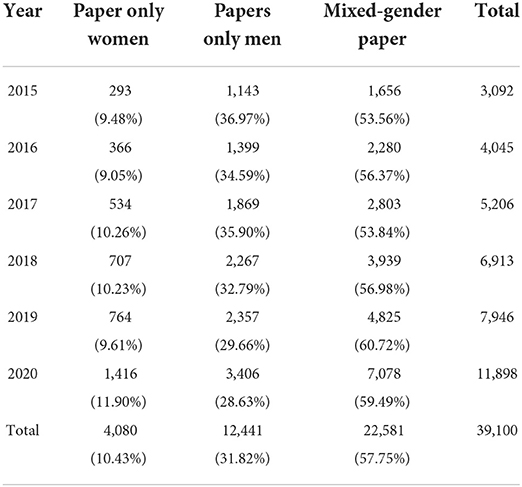
Table 1. Evolution of papers authored by women, men, and mixed-gender papers (with the percentage in parentheses).
Figure 1 shows the GPI ratio by countries of the affiliation authors. There are more publications from male researchers than female researchers in most European countries (in blue) (in line with Ghiasi et al., 2015; Paul-Hus et al., 2015, and Aksnes et al., 2019)visualization. NB-P: methodology. Such countries are also the ones with the highest number of papers (12 countries with >1,000 documents) and the most prolific countries (e.g., the United Kingdom with 6,950 unique papers, Spain with 5,788, Italy with 5,476, and Germany with 5,317).
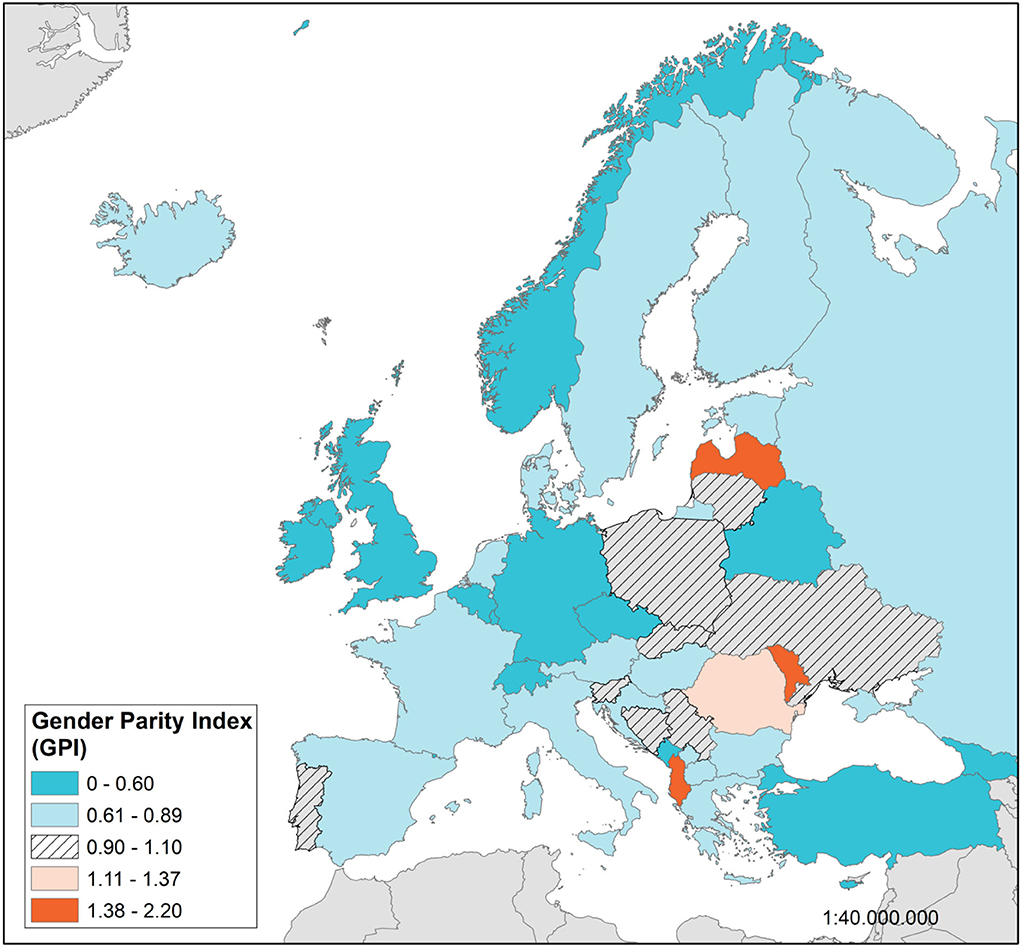
Figure 1. Adapted Gender Parity Index (GPI) by countries (0.90–1.10 gender parity; <0.90 in favor of men; >1.10 in favor of women). Only European countries are displayed on the map, although the publications' co-authors may be from outside Europe.
Poland (2,714 papers, 0.92 GPI), Portugal (1,624 papers, 0.91 GPI), Serbia (392 papers, 1.05 GPI), Slovakia (386 papers, 1.06 GPI), Lithuania (379 papers, 0.90 GPI), Slovenia (379 papers, 0.90 GPI), Ukraine (82 papers, 1.06 GPI), and Bosnia and Herzegovina (22 papers, 1.04 GPI) have the biggest gender parity (between 0.90 and 1.10). Countries with a higher proportion of female authorships than that male authorships are located in Eastern Europe [Romania (1,109 papers, 1.18 GPI), Latvia (197 papers, 1.40 GPI), and Albania (16 papers, 1.40 GPI)]. This concurs with previous research that has highlighted that Eastern European countries have a better gender balance in research author publications (see Larivière et al., 2013).
Most of the papers published are mixed-gender papers (almost 60%), where 44% had international research collaboration and 56% national (see Figure 2). Publications authored only by women have more national research collaboration (43%) than international (16%). This tendency increased during the first year of the COVID-19 pandemic (5.3 points lower in international research collaboration and 6.98 higher in no collaboration). Papers authored only by women represent 4.44% of all documents with international collaboration against 28.80% from papers authored only by men (in line with Abramo et al., 2013; Paul-Hus et al., 2015).
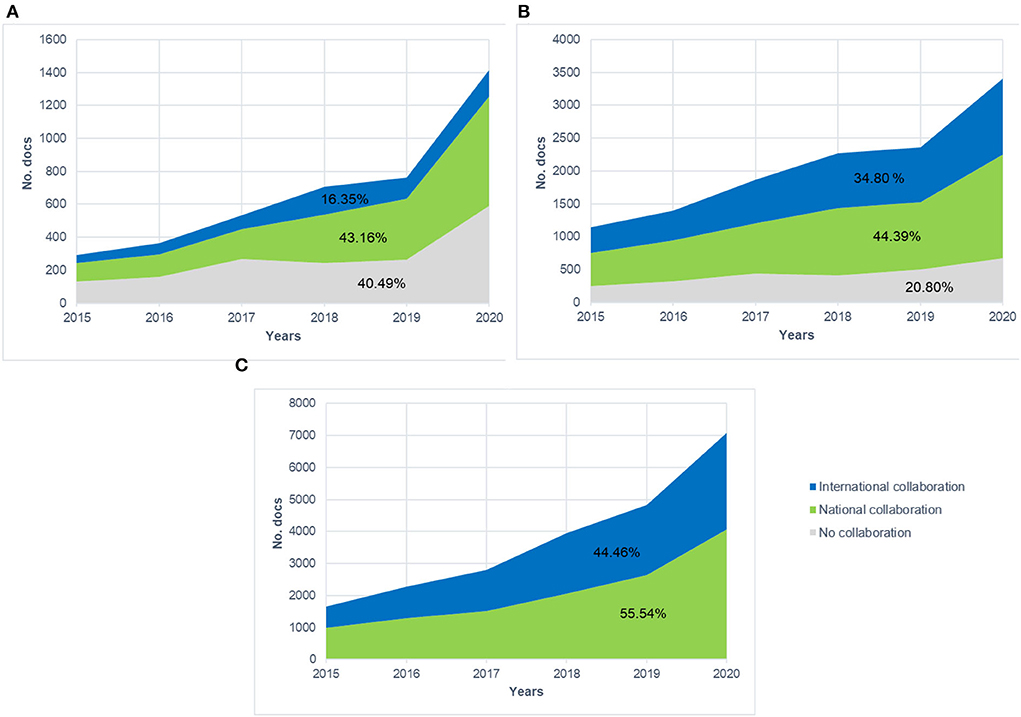
Figure 2. Collaboration evolution (2015–2020) of (A) papers authored by women; (B) papers authored by men; (C) mixed-gender papers, in international collaboration (blue), national collaboration (green), and no collaboration (gray).
Figure 3 shows the research collaboration differences in papers authored only by women. The results highlight that, although there is a better gender balance (measured by GPI values) and a predominance of female authors in Eastern countries, researchers from these countries either collaborate more on a national level or do not collaborate (e.g., Poland and Romania). Papers with international research collaboration are mainly driven by female authors from Western countries (e.g., the United Kingdom, Spain, France, Germany, and The Netherlands), which complements Larivière et al. (2013) and Fox et al. (2017). A similar pattern is presented in mixed-gender papers, with this tendency being more skewed in papers authored only by men (see Supplementary Figures S1, S2).
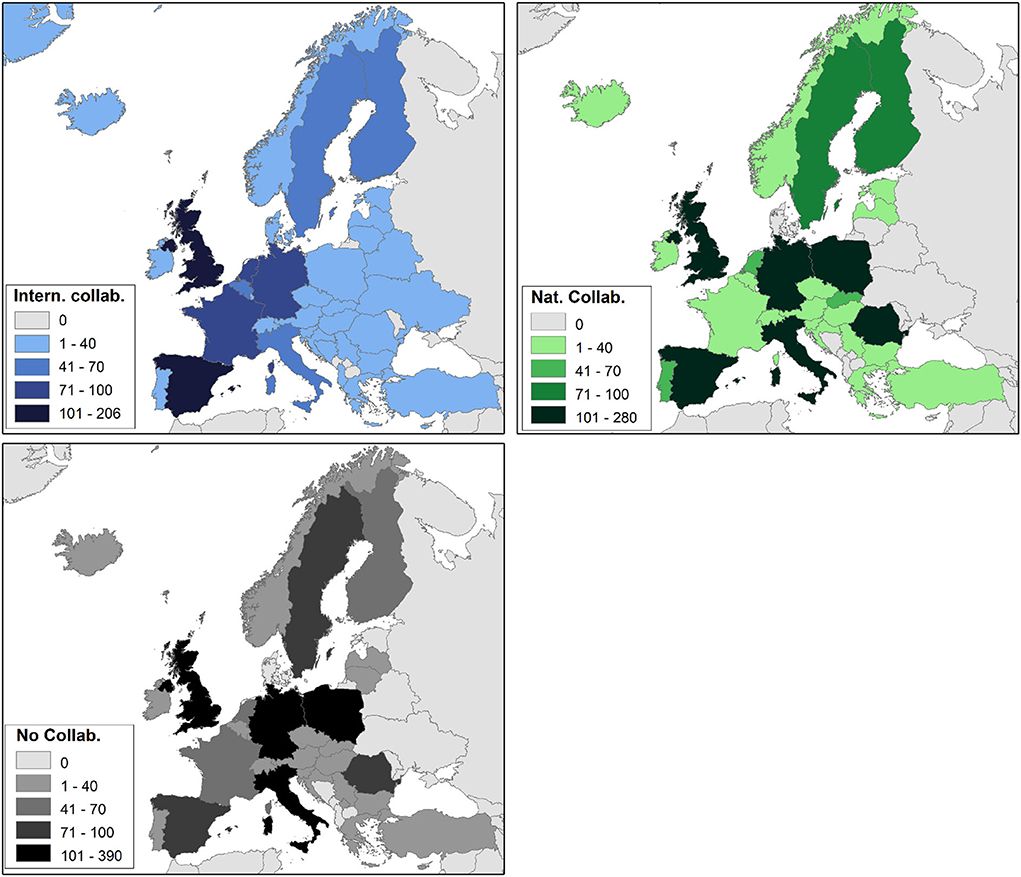
Figure 3. Collaboration maps by papers authored only by women, with international collaboration (blue), national collaboration (green), and no collaboration (gray).
Papers with female authorship in sustainability research have a significantly lower impact (e.g., 8.49 citations/doc authored only by women and 7.88 citations/doc mixed-gender papers) than papers with only male authorship (14.29 citations/doc) (concurring with Zhang et al., 2022). This citation gap is also shown in the papers not cited (31 out of 100 papers authored only by women have not had any citation vs. 22 out of 100 men's papers). As this is key in academic promotion, the citation gap increases gender inequality.
Figure 4 shows the differences between research fields in sustainability peer-review publications in Europe, where the results of the sustainability research category in WoS are skewed to the natural and applied sciences. The proportion of female research production, as unique authors, ranges between 0 and 36% of authorships in all research fields. Women have a low publishing percentage in STEM fields (see Figure 4), while the proportion of papers authored only by women is almost one-third in three fields [e.g., social sciences (35.85%), business (32.15%), and humanities (35.85%)]. However, even in such research fields, the percentage of papers authored only by men is higher than the publications authored only by women. This shows the underrepresentation of female production even in fields where women are not a minority (in line with European Commission, 2021a). Although the proportion of mixed-gender papers is almost 60%, only in seven fields (out of 17) a percentage of >50% of mixed-gender papers is found (by analyzing individually each research field).
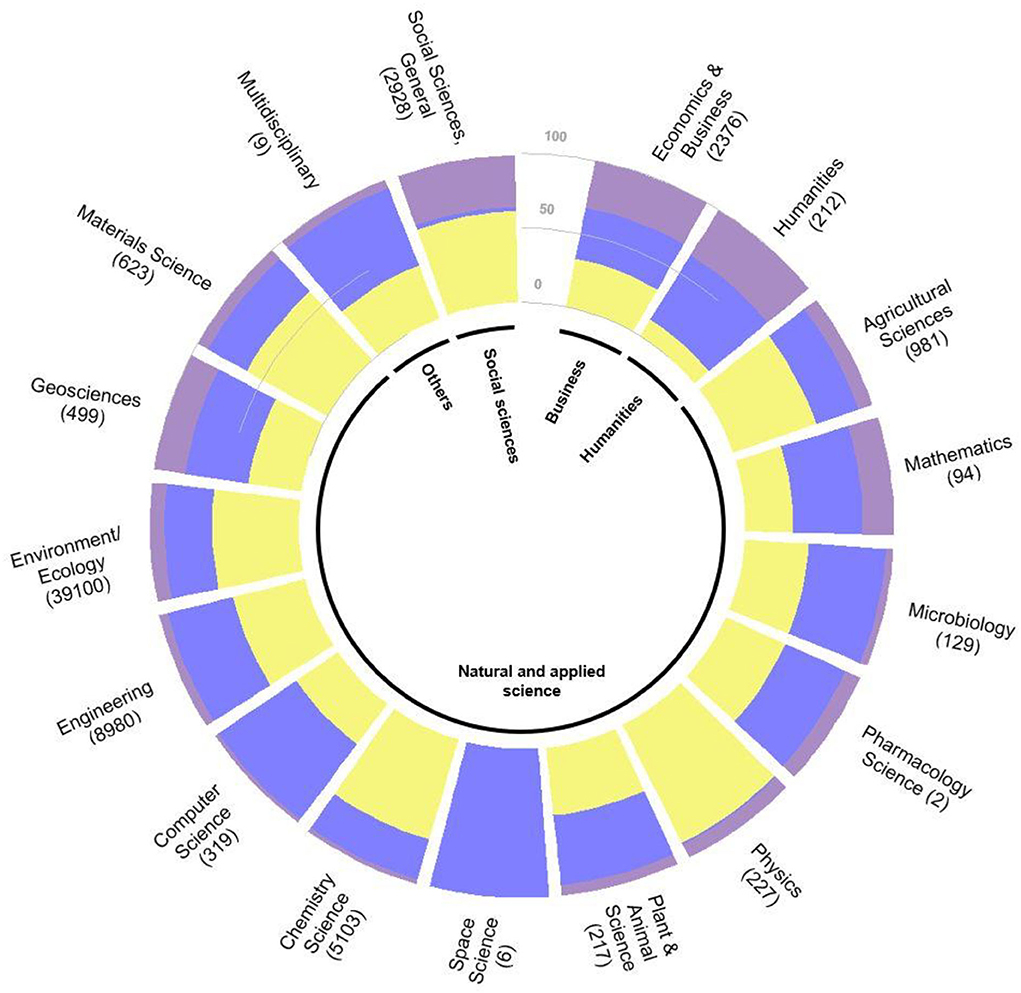
Figure 4. Circular stacked barplot of the percentage of papers with unique female representation (purple), only male representation (blue), and mixed-gender papers (yellow) by InCites fields. The number of documents is indicated within parentheses. Each paper can be classified into multiple categories.
Gender leadership in sustainability research
The results show that there is a considerable gender gap in sustainability research leadership. Female first authorships are substantially lower than male first authorships (38.61% women vs. 61.39% men), and this gap is even higher for the last authorship position (30.07% women and 69.93% men), which is commonly related to seniority. However, these positions for women improved over the period studied (6.11 points higher for female last authorship and 5.96 higher in first authorships) (Figure 5). Female researchers are more likely to be listed as the first author when the last author is a woman (55 out of 100 women vs. 31 out of 100 men), which reflects that senior female authors have higher rates of mentorship of female first authors, concurring with Aakhus et al. (2018) and Malchuk et al. (2021).
In terms of research impact, papers with women in the first and last author positions have lower recognition (fewer citations) from the scientific communities than those papers with men in the same positions, e.g., 5.05 citations/doc female first (vs. 9.41 men) and 3.73 citations/doc last (vs. 10.73 men). Similarly, female authors are more likely to be not cited when they sign in the last position (18.31% of papers by women and 15.10% of papers by men).
Figure 6 shows the proportion of male and female first and last authors in each InCites field. The proportion of female authors in research leadership positions (first and last position) is lower than those of male authors in both positions in all fields (except in pharmacology, with 50%). In traditionally female-oriented fields, there is a higher proportion of female first and last authors (e.g., business with 49% as a first author, humanities and social sciences with 43%, respectively) than in traditionally male-oriented ones, having the lowest percentage gap (>0.23). The largest gender gap in both positions (first and last) is found in male-dominated fields such as physics, molecular biology and genetics, and computer science (>0.59) (STEM careers).
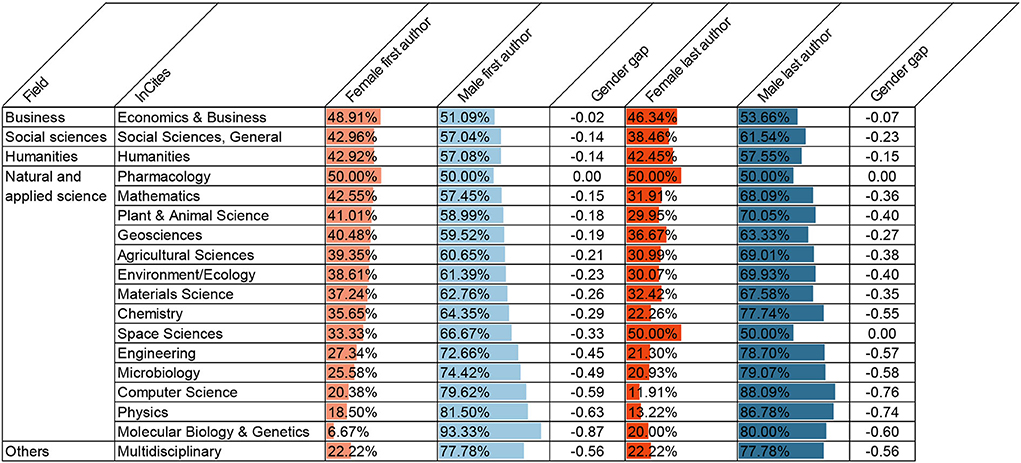
Figure 6. Gender distribution and gender gap of first and last authors in InCites fields. Ranked by the female first author in descending order.
Conclusion
Higher education institutions have undertaken considerable efforts to incorporate sustainability into their system elements, such as governance, campus operations, and assessment and reporting; however, there have been limited studies on the incorporation of sustainability in research, particularly in scientific publishing. In parallel, previous research has found that women have an important role in contributing to sustainability since they tend to have a more holistic perspective on sustainability issues and be more engaged with sustainability than men. However, there has been limited research on the contribution of women to sustainability research (i.e., in scientific publications). A bibliometric analysis of more than 39,000 documents (with 147,090 authorships) was done to fill this gap, focusing on sustainability peer-review publications in Europe.
The results show that women's contribution to sustainability research has been increasing during the last years, although the percentage of female researchers is still low. Female authorship varies in the different fields that are included in the sustainability category, but women are underrepresented even in those research fields where women are not a minority. Female authorship is higher (in relative terms) mainly in countries with a low total number of publications (e.g., Eastern Europe) than in countries with a high number of sustainability articles (e.g., Western Europe).
Female researchers tend to collaborate when they publish sustainability articles, but their levels of international collaboration among women can be boosted (particularly in Eastern Europe). This could extend their opportunities and broaden their horizons and publication impact, especially after the COVID-19 pandemic, which reduced international collaboration among female researchers.
The results show that female publications are less recognized by scientific communities (e.g., in terms of citations), which affects their promotion and salary, and this, in turn, generates negative feedback loops that affect their impact. Female researchers tend to lead sustainability papers to a lesser extent than men, especially in STEM. Female senior researchers are more likely to be mentors of female junior researchers than men, creating positive sustainability research feedback loops. This highlights the importance of having role models that can help break “the glass ceiling” and reduce “the leaky pipeline” phenomenon to address the challenges that female researchers face.
Achieving gender equality is essential for sustainability research in becoming more sustainable. More support should be provided to female researchers to help foster women's sustainability engagement and holistic perspectives, reduce the existing negative feedback loops, and promote the positive ones in HEIs. With apologies to the White Rabbit in Alice in Wonderland: “We are late, we are late, for gender equality in sustainability research”.
This article provides the basis for further analyses on gender equality in sustainability research and implementation. Thus, further research should focus on conducting empirical analyses, testing whether the assumptions that were used in this article are valid, as well as analyzing female researchers' contribution to sustainability projects (e.g., grant allocation disparities in Europe), their contribution per European country, their academic career path, as well as whether there are barriers that are stopping international collaboration among women in sustainability research.
Data availability statement
The original contributions presented in the study are included in the article/Supplementary material, further inquiries can be directed to the corresponding author/s.
Author contributions
MB-G and NB-P: conceptualization, writing—original draft preparation, and writing—review and editing. MB-G: visualization. NB-P: methodology and formal analysis. Both authors contributed to the article and approved the submitted version.
Acknowledgments
A great deal of gratitude goes to Prof. Rodrigo Lozano for his valuable suggestions to improve this article, as well as Dr. Andrés Pandiella-Dominique and Dr. Enrique Orduña-Malea, for their comments and feedback that greatly improved the manuscript.
Conflict of interest
The authors declare that the research was conducted in the absence of any commercial or financial relationships that could be construed as a potential conflict of interest.
Publisher's note
All claims expressed in this article are solely those of the authors and do not necessarily represent those of their affiliated organizations, or those of the publisher, the editors and the reviewers. Any product that may be evaluated in this article, or claim that may be made by its manufacturer, is not guaranteed or endorsed by the publisher.
Supplementary material
The Supplementary Material for this article can be found online at: https://www.frontiersin.org/articles/10.3389/frsus.2022.959438/full#supplementary-material
The query used in Web of Science (WoS) is described as follows:
Green & Sustainable Science & Technology (Web of Science Categories) and 2015 or 2016 or 2017 or 2018 or 2019 or 2020 (Publication Years) and ENGLAND or ITALY or SPAIN or GERMANY or FRANCE or NETHERLANDS or POLAND or SWEDEN or PORTUGAL or TURKEY or BELGIUM or ROMANIA or SWITZERLAND or NORWAY or FINLAND or GREECE or AUSTRIA or SCOTLAND or CZECH REPUBLIC or IRELAND or SLOVAKIA or LITHUANIA or HUNGARY or SERBIA or WALES or LATVIA or CROATIA or SLOVENIA or ESTONIA or NORTH IRELAND or BULGARIA or ICELAND or LUXEMBOURG or ALBANIA or NORTH MACEDONIA or KOSOVO or MONACO or GIBRALTAR or ANDORRA or SAN MARINO (Countries/Regions)
Supplementary Figure S1. Collaboration maps by papers authored only by men.
Supplementary Figure S2. Collaboration maps for mixed-gender papers.
Footnotes
References
Aakhus, E., Mitra, N., Lautenbach, E., and Joffe, S. (2018). Gender and byline placement of co-first authors in clinical and basic science journals with high impact factors. JAMA 319, 610. doi: 10.1001/jama.2017.18672
Abramo, G., D'Angelo, C. A., and Murgia, G. (2013). Gender differences in research collaboration. J. Informetr. 7, 811–822. doi: 10.1016/j.joi.2013.07.002
Aksnes, D. W., Piro, F. N., and Rørstad, K. (2019). Gender gaps in international research collaboration: a bibliometric approach. Scientometrics 120, 747–774. doi: 10.1007/s11192-019-03155-3
Amaral, A. R., Rodrigues, E., Gaspar, A. R., and Gomes, Á. (2020). A review of empirical data of sustainability initiatives in university campus operations. J. Clean. Prod. 250, 119558. doi: 10.1016/j.jclepro.2019.119558
Araújo, E. B., Araújo, N., Moreira, A. A., Herrmann, H. J., and Andrade, J. S. Jr. (2017). Gender differences in scientific collaborations: Women are more egalitarian than men. PloS one 12:e0176791. doi: 10.1371/journal.pone.0176791
Bautista-Puig, N., Mañana-Rodríguez, J., and Serrano-López, A. E. (2021). Role taxonomy of green and sustainable science and technology journals: exportation, importation, specialization and interdisciplinarity. Scientometrics 126, 3871–3892. doi: 10.1007/s11192-021-03939-6
Bell, M. L., and Fong, K. C. (2021). Gender differences in first and corresponding authorship in public health research submissions during the COVID-19 pandemic. Am. J. Public Health 111, 159–163. doi: 10.2105/AJPH.2020.305975
Chatterjee, P., and Werner, R. M. (2021). Gender disparity in citations in high-impact journal articles. JAMA Network Open 4, e2114509. doi: 10.1001/jamanetworkopen.2021.14509
Derrick, G. E., Chen, P.-Y., van Leeuwen, T., Larivière, V., and Sugimoto, R. (2021). The Academic Motherload: Models of Parenting Engagement and the Effect on Academic Productivity and Performance. Available online at: https://arxiv.org/abs/2108.05376 (accessed May 24, 2022).
Desha, C. J., Hargroves, K., and Smith, M. H. (2009). Addressing the time lag dilemma in curriculum renewal towards engineering education for sustainable development. Int. J. Sustain. Higher Educ. 10, 184–199. doi: 10.1108/14676370910949356
Disterheft, A., Ferreira da Silva Caeiro, S. S., Ramos, M. R., and de Miranda Azeiteiro, U. M. (2012). Environmental Management Systems (EMS) implementation processes and practices in European higher education institutions – Top-down versus participatory approaches. J. Clean. Prod. 31, 80–90. doi: 10.1016/j.jclepro.2012.02.034
Ekström Hagevall, S. (2021). Shattering the Glass Ceiling to Ensure a Sustainable Future. Available online at: http://hig.diva-portal.org/smash/record.jsf?dswid=-4986&pid=diva2%3A1573779&c=1&searchType=SIMPLE&language=en&query=Shattering+the+Glass+Ceiling+to+Ensure+a+Sustainable+Future&af=%5B%5D&aq=%5B%5B%7B%22categoryId%22%3A%2211768%22%7D%5D%5D&aq2=%5B%5B%5D%5D&aqe=%5B%5D&noOfRows=50&sortOrder=author_sort_asc&sortOrder2=title_sort_asc&onlyFullText=false&sf=all (accessed April 18, 2022).
European Commission (2021a). MORE4: Support Data Collection and Analysis Concerning Mobility Patterns and Career Paths of Researchers: Survey on Researchers in European Higher Education Institutions. Publications Office. Available online at: https://data.europa.eu/doi/10.2777/132356 (accessed April 18, 2022).
European Commission (2021b). She Figures 2021: Gender in Research and Innovation: Statistics and Indicators. Publications Office. Available online at: https://data.europa.eu/doi/10.2777/06090 (accessed April 18, 2022).
European Commission (2022). Gender Equality in Research and Innovation. Available online at: https://ec.europa.eu/info/research-and-innovation/strategy/strategy-2020-2024/democracy-and-rights/gender-equality-research-and-innovation_en (accessed April 15, 2022).
European Institute for Gender Equality (2021). Gender Statistics Database. Available online at: https://eige.europa.eu/gender-statistics/dgs/indicator/wmidm_educ__wmid_acadsci (accessed April 16, 2022).
Eurostat (2021). Statistics on Education, Research and Development (R&D). R&D Personnel. Available online at: https://ec.europa.eu/eurostat/statistics-explained/index.php?title=R%26D_personnel (accessed April 18, 2022).
Fox, C. W., Ritchey, J. P., and Paine, C. E. T. (2018). Patterns of authorship in ecology and evolution: first, last, and corresponding authorship vary with gender and geography. Ecol. Evol. 8, 11492–11507. doi: 10.1002/ece3.4584
Fox, M. F., Realff, M. L., Rueda, D. R., and Morn, J. (2017). International research collaboration among women engineers: Frequency and perceived barriers, by regions. J. Technol. Transf. 42, 1292–1306. doi: 10.1007/s10961-016-9512-5
Ghiasi, G., Larivière, V., and Sugimoto, C. R. (2015). On the compliance of women engineers with a gendered scientific system. PLoS ONE 10, e0145931. doi: 10.1371/journal.pone.0145931
Grogan, K. E. (2019). How the entire scientific community can confront gender bias in the workplace. Nat. Ecol. Evol. 3, 3–6. doi: 10.1038/s41559-018-0747-4
Gupta, N., Banerjee, S., Choudhury, K. J., and Prabhakar, H. (2021). Women representation as first and corresponding authors in neuroanesthesiology and neurocritical care journals: a retrospective analysis. J. Neurosurg. Anesthesiol. 33, 308–314. doi: 10.1097/ANA.0000000000000788
Heijstra, T. M., Einarsdóttir, Þ*., Pétursdóttir, G. M., and Steinþórsdóttir, F. S. (2017). Testing the concept of academic housework in a European setting: part of academic career-making or gendered barrier to the top? Eur. Educ. Res. J. 16, 200–214. doi: 10.1177/1474904116668884
Helgesson, G., and Eriksson, S. (2019). Authorship order. Learned Publish. 32, 106–112. doi: 10.1002/leap.1191
Huang, J., Gates, A. J., Sinatra, R., and Barabási, A.-L. (2020). Historical comparison of gender inequality in scientific careers across countries and disciplines. Proc. Nat. Acad. Sci. 117, 4609–4616. doi: 10.1073/pnas.1914221117
Karatzoglou, B. (2013). An in-depth literature review of the evolving roles and contributions of universities to Education for Sustainable Development. J. Clean. Prod. 49, 44–53. doi: 10.1016/j.jclepro.2012.07.043
Karimi, F., Wagner, C., Lemmerich, F., Jadidi, M., and Strohmaier, M. (2016). “Inferring gender from names on the web: a comparative evaluation of gender detection methods,” in Proceedings of the 25th International Conference Companion on World Wide Web - WWW '16 Companion, 53–54.
Khalikova, V. R., Jin, M., and Chopra, S. S. (2021). Gender in sustainability research: inclusion, intersectionality, and patterns of knowledge production. J. Indust. Ecol. 25, 900–912. doi: 10.1111/jiec.13095
Larivière, V., Ni, C., Gingras, Y., Cronin, B., and Sugimoto, C. R. (2013). Bibliometrics: global gender disparities in science. Nature 504, 211–213. doi: 10.1038/504211a
Leal Filho, W., Wall, T., Salvia, A. L., Frankenberger, F., Hindley, A., Mifsud, M., et al. (2021). Trends in scientific publishing on sustainability in higher education. J. Clean. Prod. 296, 126569. doi: 10.1016/j.jclepro.2021.126569
Lozano, R. (2010). Diffusion of sustainable development in universities' curricula: an empirical example from Cardiff University. J. Clean. Prod. 18, 637–644. doi: 10.1016/j.jclepro.2009.07.005
Lozano, R., and Barreiro-Gen, M. (2019). Analysing the factors affecting the incorporation of sustainable development into European Higher Education Institutions' curricula. Sustain. Dev. 27, 965–975. doi: 10.1002/sd.1987
Lozano, R., Barreiro-Gen, M., Lozano, F., and Sammalisto, K. (2019). Teaching sustainability in european higher education institutions: assessing the connections between competences and pedagogical approaches. Sustainability 11, 1602. doi: 10.3390/su11061602
Lozano, R., Ceulemans, K., Alonso-Almeida, M., Huisingh, D., Lozano, F. J., Waas, T., et al. (2015). A review of commitment and implementation of sustainable development in higher education: results from a worldwide survey. J. Clean. Prod. 108, 1–18. doi: 10.1016/j.jclepro.2014.09.048
Malchuk, A. M., Coffman, M., Wilkinson, E., and Jabbarpour, Y. (2021). Gender concordance of first and senior authors in family medicine journals. Fam. Med. 53, 92–97. doi: 10.22454/FamMed.2021.355251
Matten, D., and Moon, J. (2004). Corporate social responsibility education in Europe. J. Bus. Ethics 54, 323–337. doi: 10.1023/B:BUSI.0000049886.47295.3b
Morgan, A. C., Way, S. F., Hoefer, M. J. D., Larremore, D. B., Galesic, M., and Clauset, A. (2021). The unequal impact of parenthood in academia. Sci. Adv. 7, eabd1996. doi: 10.1126/sciadv.abd1996
Paul-Hus, A., Bouvier, R. L., Ni, C., Sugimoto, C. R., Pislyakov, V., and Larivière, V. (2015). Forty years of gender disparities in Russian science: a historical bibliometric analysis. Scientometrics 102, 1541–1553. doi: 10.1007/s11192-014-1386-4
Ross, M. B., Glennon, B. M., Murciano-Goroff, R., Berkes, E. G., Weinberg, B. A., and Lane, J. I. (2022). Women are credited less in science than men. Nature 608, 135–145. doi: 10.1038/s41586-022-04966-w
Rosser, S. V. (2014). “Senior compared to junior women academic scientists: similar or different needs?,” in Advances in Gender Research, eds V. Demos, C. W. Berheide, and M. T. Segal, Vol. 19 (Bingley: Emerald Group Publishing Limited), 221–241.
Sammalisto, K., Sundström, A., von Haartman, R., Holm, T., and Yao, Z. (2016). Learning about sustainability—what influences students' self-perceived sustainability actions after undergraduate education? Sustainability 8, 510. doi: 10.3390/su8060510
Santos, J. M., Horta, H., and Amâncio, L. (2021). Research agendas of female and male academics: a new perspective on gender disparities in academia. Gend. Educ. 33, 625–643. doi: 10.1080/09540253.2020.1792844
Torabian, J. (2019). Revisiting global university rankings and their indicators in the age of sustainable development. Sustain. J. Record 12, 167–172. doi: 10.1089/sus.2018.0037
Ucar, I., Torre, M., and Elías, A. (2022). Mind the gender gap: COVID-19 lockdown effects on gender differences in preprint submissions. PLoS ONE 17, e0264265. doi: 10.1371/journal.pone.0264265
Valls Martínez, M., del, C., Cruz Rambaud, S., and Parra Oller, I. M. (2019). Gender policies on board of directors and sustainable development. Corporate Soc. Responsibility Environ. Manage. 26, 1539–1553. doi: 10.1002/csr.1825
von Haartman, R., Sammalisto, K., Lozano, R., and Blomqvist, P. (2017). A longitudinal comparison of sustainability learning between men and women in engineering and nursing programmes. Sustainability 9, 1464. doi: 10.3390/su9081464
Walker, R. L., Sykes, L., Hemmelgarn, B. R., and Quan, H. (2010). Authors' opinions on publication in relation to annual performance assessment. BMC Med. Educ. 10:21. doi: 10.1186/1472-6920-10-21
West, J. D., Jacquet, J., King, M. M., Correll, S. J., and Bergstrom, C. T. (2013). The role of gender in scholarly authorship. PLoS ONE 8, e66212. doi: 10.1371/journal.pone.0066212
Withycombe Keeler, L., Wiek, A., Lang, D. J., Yokohari, M., van Breda, J., Olsson, L., et al. (2016). Utilizing international networks for accelerating research and learning in transformational sustainability science. Sustain. Sci. 11, 749–762. doi: 10.1007/s11625-016-0364-6
Keywords: gender equality, sustainability, bibliometric analysis, sustainability research, research evaluation, higher education institutions (HEIs)
Citation: Barreiro-Gen M and Bautista-Puig N (2022) Women in sustainability research: Examining gender authorship differences in peer-reviewed publications. Front. Sustain. 3:959438. doi: 10.3389/frsus.2022.959438
Received: 01 June 2022; Accepted: 05 August 2022;
Published: 31 August 2022.
Edited by:
Federica Murmura, University of Urbino Carlo Bo, ItalyReviewed by:
Annalisa Sentuti, University of Urbino Carlo Bo, ItalyLolita Liberatore, G. d'Annunzio University of Chieti and Pescara, Italy
Roberta Bocconcelli, University of Urbino Carlo Bo, Italy
Giada Pierli, University of Urbino Carlo Bo, Italy
Copyright © 2022 Barreiro-Gen and Bautista-Puig. This is an open-access article distributed under the terms of the Creative Commons Attribution License (CC BY). The use, distribution or reproduction in other forums is permitted, provided the original author(s) and the copyright owner(s) are credited and that the original publication in this journal is cited, in accordance with accepted academic practice. No use, distribution or reproduction is permitted which does not comply with these terms.
*Correspondence: Maria Barreiro-Gen, bWFyaWEuYmFycmVpcm9AaGlnLnNl
 Maria Barreiro-Gen
Maria Barreiro-Gen Núria Bautista-Puig
Núria Bautista-Puig